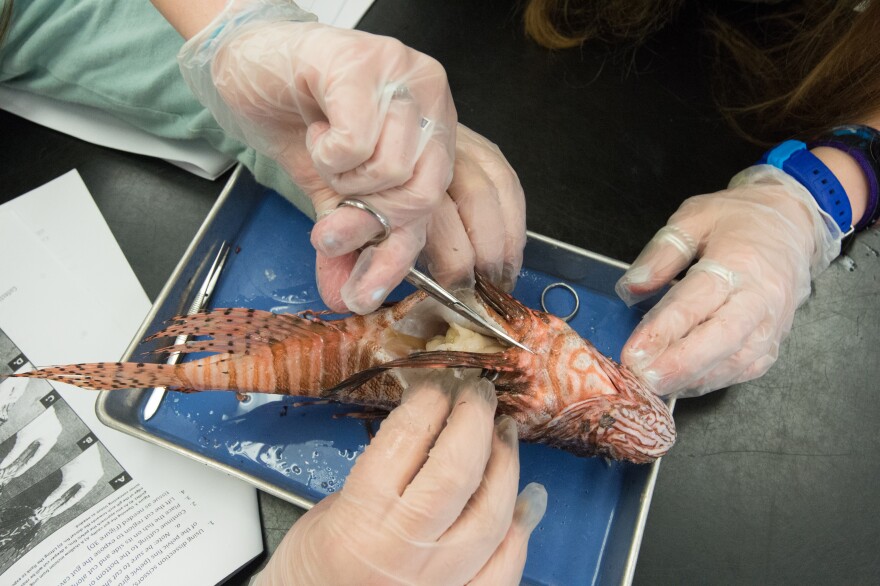The highly invasive lionfish has been become a dominant predator since it was first documented in the Gulf off Pensacola in 2010.
Armed with venomous spines, a voracious appetite and no natural predator, it’s common to find 50 to 60 lionfish on just one reef, said Andy Ross with the Gulf Coast Lionfish Coalition.
But what native species are these aggressive invaders eating?
“That’s what you guys are here to help us figure out,” University of West Florida professor Jeff Eble recently told students in a marine biology class at Gulf Breeze High School.

Eble, the research coordinator for the Gulf Islands Research and Education Center, has with the help of some of his UWF students been training local middle and high school students and teachers how to dissect lionfish and then identify the prey found in their stomachs using a process known as DNA barcoding. This is done by isolating, copying and reading the DNA sequence from each prey item, and then comparing it against a reference library of known DNA sequences.
“What we’re trying to do is to get a better understanding of the impacts of lionfish and to give students an opportunity to directly participate in ongoing research,” Eble said.
Seven schools participated in the partnership this year. In addition to Gulf Breeze High School, other schools that are participating in the project are Booker T. Washington High School, Escambia High School, Navarre High School, Pensacola High School, West Florida High School and Woodlawn Beach Middle School.
An award from the UWF Pace Academic Development Grant was used to purchase the equipment and supplies needed to get the project up and running.

Amy Cozart, a teacher at Woodlawn Beach Middle School, said her eighth grade students found razorfish, flounder – even other lionfish— inside the stomachs of the samples they dissected. She said her students were excited to not only dissect the lionfish, but also conduct gel electrophoresis, a process that lets students view DNA in the classroom.
“And then I thought that the bioinformatics, sitting in the computer lab, would be kind of a slow day, and they were on fire about it – writing down what prey items they had discovered, working on cleaning up their DNA,” Cozart said. “They really did a fantastic job. I was really pleased from start to finish with their level of engagement with it.”
Five teachers Eble worked with received grants to implement the project in their schools. Cozart was awarded three grants, including a $10,000 grant from Gulf Breeze Will Do, a local philanthropic organization. She said the middle school now has a college-level genetics lab.
To kick off the lionfish DNA barcoding project, in partnership with BioRad Laboratories and with support from Escambia and Santa Rosa County school districts, Eble and some of his UWF students held a series of workshops last summer for 15 teachers.
“The idea is that we’re not just providing this training one-off for the students, but we’re increasing the teaching capacity of the schools themselves,” Eble said. “We’re providing training for the teachers and giving them access to the necessary equipment and providing help with grants.”
Ross, a local dive operator, helped form the Gulf Coast Lionfish Coalition in 2014 to educate the public and increase awareness of the threats posed by lionfish. Ross not only donated many of the lionfish used in the DNA barcoding project, he also detailed exactly where he found them, which helps with the research, Eble said.
“The more info we have on the individual lionfish, where they came from, what time of day they were collected, what time of year they were collected, the more questions we can answer with the data down the road,” Eble said.
Ross said he and other fisherman use pole spears to catch large numbers of lionfish near artificial reefs.
“We really want to create this commercialization of lionfish, which is probably the most viable solution to the problem,” Ross said. “Because the more demand there is for lionfish, the more people will take them out, the more people will eat them.”
Eble said that, through the project, more than 500 middle and high school students have gained experience conducting standard genetic analyses. The results of the students’ DNA barcoding are being put in a database, he said.
“We’re going to allow future classes to have access to the database so they can conduct their own hypothesis testing, and once enough samples have been analyzed we’ll be submitting the data the students helped generate for publication” Eble said.
This article is part of a collaboration between WUWF and the UWF Center for Research and Economic Opportunity.








